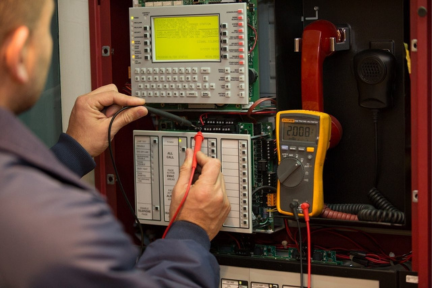
A Fire Alarm Systems Installation Service specializes in designing, installing, and maintaining systems that detect and alert occupants to fire hazards, ensuring safety and compliance with regulations. These systems are essential for both residential and commercial properties.
Components of a Fire Alarm System:
- Control Panel:
- The central hub that monitors and manages the entire system.
- Displays alerts and provides manual control options.
- Fire Detectors:
- Smoke Detectors: Identify smoke particles from potential fires.
- Heat Detectors: Detect abnormal temperature rises.
- Flame Detectors: Sense infrared or ultraviolet light from flames.
- Alarm Devices:
- Sounders/Sirens: Emit loud sounds to alert occupants.
- Strobe Lights: Provide visual alerts, especially for the hearing impaired.
- Manual Call Points:
- Allow occupants to manually trigger the alarm in case of emergencies.
- Notification Systems:
- Notify building occupants and emergency services automatically.
- Backup Power Supply:
- Keeps the system operational during power outages.
- Monitoring Systems:
- Remote monitoring for instant alerts to fire departments or property owners.
Key Steps in Fire Alarm System Installation:
- Site Assessment:
- Evaluate the building layout to identify high-risk areas.
- Determine the best locations for detectors, call points, and alarms.
- System Design:
- Create a plan that meets safety regulations (e.g., NFPA standards).
- Tailor the system for residential, commercial, or industrial needs.
- Equipment Installation:
- Install smoke and heat detectors in key areas such as kitchens, basements, and corridors.
- Position alarms and sirens to ensure maximum coverage.
- System Integration:
- Connect alarms to sprinkler systems, emergency lighting, and monitoring services if applicable.
- Testing and Commissioning:
- Test all components to ensure proper functionality.
- Simulate fire scenarios to verify responsiveness and alert mechanisms.
- Training and Documentation:
- Provide training on how to operate and maintain the system.
- Offer documentation for compliance and user reference.
- Maintenance and Support:
- Regular inspections and maintenance to ensure long-term reliability.
- Address any issues or replace faulty components promptly.
Benefits of Professional Installation:
- Ensures compliance with local fire safety codes and regulations.
- Reduces the risk of false alarms or system failures.
- Provides peace of mind with a properly installed and maintained system.
- Offers tailored solutions for specific property needs.
